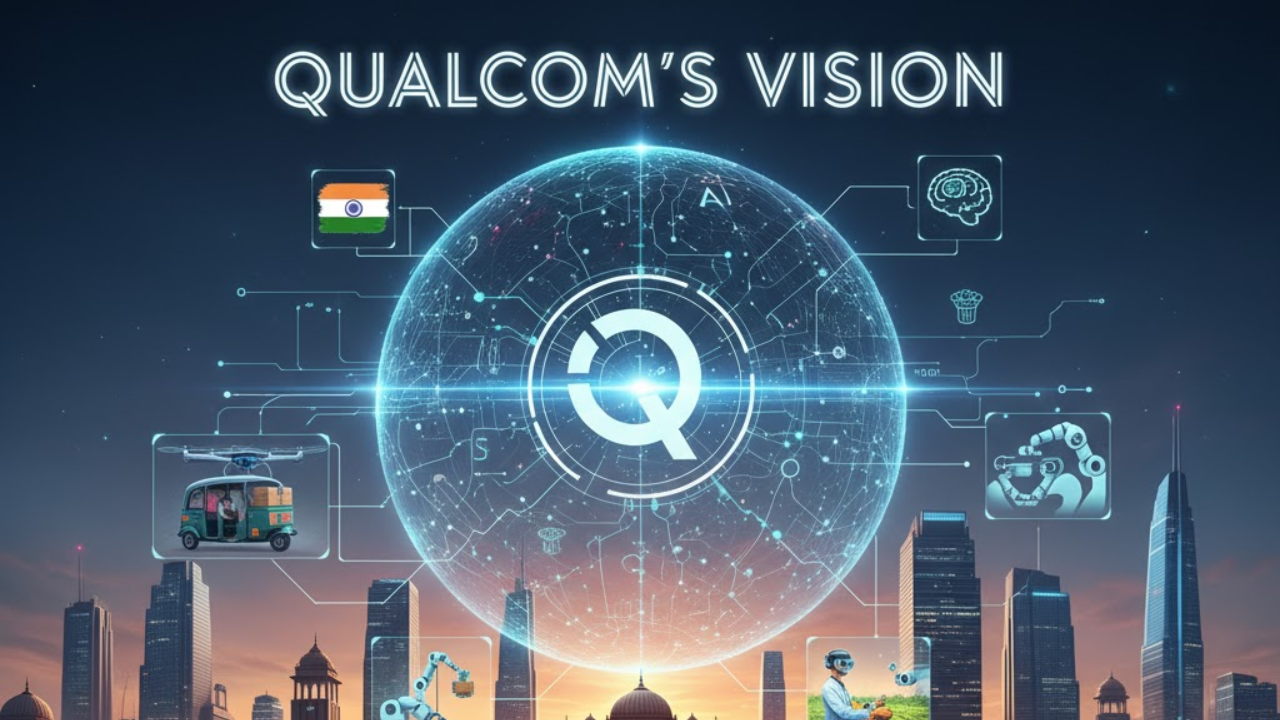
Post by : Naveen Mittal
In a recent interview, Qualcomm President Cristiano R. Amon outlined a bold vision: India is not merely a market for technology, but a laboratory for agentic AI — an AI paradigm in which intelligence is embedded directly in devices, not just housed in cloud data centers. He proposed that 6G will serve as connectivity for the age of AI, enabling devices to act autonomously, sense context, and become new generations of “apps” or agents.
This shift in perspective opens a new front in the global AI / connectivity race. India — with its massive population, strong engineering talent, and progressive tech policies — becomes a proving ground for the next wave of AI innovation.
This article explores this idea deeply: what "agentic AI" means, Qualcomm’s strategy, the role of 6G, India’s unique position, challenges, opportunity landscape, and long-term implications for devices, infrastructure, and society.
Agentic AI refers to artificial intelligence systems that do more than respond to prompts — they act autonomously, plan, reason, and take initiative. Rather than just being tools, these are AI agents that understand context, anticipate needs, and execute tasks independently.
In contrast to passive AI (e.g. basic chatbots), agentic systems combine perception, reasoning, and action. That demands infrastructure and computing capabilities distributed across the network — not centralized in distant servers.
Qualcomm sees agentic AI as the evolution of how we use devices: no longer passive endpoints, but active agents that live on phones, wearables, vehicles, and edge nodes — powered by real-time connectivity and local intelligence.
Amon emphasized that past generations had distinct goals:
2G: voice connectivity
3G: mobile internet
4G: broadband
5G: high-speed data
But 6G, he argues, is about creating networks that understand context for AI agents. In 6G, networks will not just transmit bits — they will sense, coordinate, and support intelligence at the edge.
Under this vision, connectivity and AI become symbiotic: the network is aware of what devices are doing, and devices integrate with connectivity to act.
Instead of shuttling all computation to the cloud, Qualcomm plans to push AI models directly onto devices — phones, PCs, autos, XR systems. Those devices will combine local sensing, memory, model inference, and decision-making into “agentic experiences”.
Qualcomm calls these next-gen intelligent systems agentic experience platforms — essentially, agents replacing the static app model.
India, in Amon’s view, is ideally suited for building these systems. He spoke of the India AI Mission and Semiconductor Mission as strategic overlaps with Qualcomm’s ambitions. With significant mobile and computing infrastructure already in play, India offers the scale, talent, and customer diversity to test and refine agentic systems in real-world conditions.
Why place this vision in India? Several compelling reasons:
Scale and Variety
A large, diverse user base provides abundant real-world scenarios — different geographies, languages, environments, devices. Agents need to adapt across extremes.
Strong Developer Ecosystem
Millions of engineers are versed in software and hardware. Localizing AI models, optimizations, and applications is more feasible.
Government Support & Policy Vision
India’s AI Mission, semiconductor initiatives, digital infrastructure goals, and public data programs provide policy tailwinds.
Existing Connectivity and Device Penetration
Smartphones, 5G rollout, IoT expansion, and edge computing platforms already exist — forming a base to evolve toward 6G + agentic AI.
Cost-Sensitive Environment
In price-sensitive markets, optimizing compute, power, and efficiency is critical. Agentic AI demands edge efficiency — India’s constraints are a strength for creating lean designs.
Together, these factors make India more than a market — a living lab for next-gen AI systems under real-world constraints.
To realize this vision, Qualcomm is building multiple partnerships and ecosystem components:
Collaboration with Google Cloud
Qualcomm and Google Cloud are deepening their partnership to deliver agentic AI experiences in vehicles, combining cloud AI models with Snapdragon chip platforms for hybrid edge-cloud intelligence. Their joint systems enable conversational, context-aware agents in automotive domains.
TCS Co-Innovation Lab in Bengaluru
Qualcomm has teamed with Tata Consultancy Services (TCS) to establish an AI / edge lab in Bengaluru focusing on edge AI platforms, custom industry use cases, and scalable solutions. This lab is expected to prototype intelligent systems for healthcare, industrial IoT, smart infrastructure, and more.
Local manufacturing and R&D expansion
Qualcomm is reportedly expanding its investments in India’s semiconductor and AI ecosystem. The belief is that deep local engagement — design, R&D & deployment — is essential to make agentic AI viable.
These moves signal that Qualcomm’s vision is not just theoretical — it is being mapped into infrastructure, prototypes, and ecosystem building in India.
If India becomes the laboratory for agentic AI, what kinds of applications might arise?
Phones or PCs that understand your context (location, usage patterns, preferences) and act proactively — scheduling, reminders, management — without explicit commands.
Homes, offices, and factories where sensors and actuators communicate with agentic nodes to optimize climate, security, workflow, and maintenance.
Cars that don’t just drive — they understand context, route optimization, passenger comfort, predictive behavior — combining perception, connectivity, and decision-making within the vehicle.
Wearables that monitor vitals, detect anomalies, consult patterns, and take actions (like alerting caregivers) — all autonomously and privately on device.
Industrial agents managing predictive maintenance, quality control, supply chains, and real-time optimization without needing constant cloud access.
Because agentic AI operates across edge, cloud, and network, its applications cut across consumer, industrial, healthcare, and infrastructure domains.
The vision is bold — but executing it at scale faces considerable challenges:
Hardware & Efficiency Constraints
Embedding AI agents on devices means constraints on compute, memory, power, and thermal budgets. Models must be optimized, quantized, and efficient.
Network Latency & Reliability
Agentic experiences demand real-time responsiveness. Even with 6G promises, networks must support low-latency, high-reliability, and ubiquitous coverage.
Data Privacy & Governance
Agents working on context and personal data must respect privacy and regulatory norms. On-device processing helps, but secure design is vital.
Model Updating & Continual Learning
Devices must adapt over time, learn from local context, and update models safely — balancing offline/cloud and edge learning.
Interoperability & Standards
Agents will need to work across ecosystems, devices, network layers — requiring standards for compatibility, APIs, protocols.
Economic Viability
Consumer and enterprise devices must be affordable. Agentic AI must prove value beyond novelty to drive adoption.
Qualcomm’s approach — combining device intelligence, network advances (6G), and ecosystem partnerships — aims to mitigate these challenges.
India positioning as a testbed for agentic AI has both national and global significance:
Leadership Role
Successfully designing and deploying real-world agentic AI could place India as a global leader in edge intelligence and AI infrastructure.
Talent and Innovation Platform
Engineers, researchers, and startups can prototype innovations on a large scale, raising the bar for domestic AI ecosystems.
Competitiveness in Semiconductor & AI
Close integration of AI, chips, connectivity and policy can accelerate India’s semiconductor ambitions and reduce dependency.
Global Influence in AI Architecture
The design choices and standards emerging from India’s “laboratory” outputs may influence how agentic AI architectures evolve globally.
However, this also invites competition from the US, China, Europe — all seeking leadership in edge AI and intelligent connectivity.
To transform India into a practical agentic AI laboratory, here is a suggested multi-phase roadmap:
Build demonstration devices & agents (phones, wearables, IoT)
Deploy in controlled real-world contexts (campuses, smart buildings)
Collect data and performance feedback
Collaborate on early 6G trials
Deploy edge AI nodes and hybrid edge-cloud pipelines
Standardize protocols and APIs for inter-agent communication
Open agentic AI SDKs and APIs
Host innovation labs (like TCS-Qualcomm) to co-develop vertical apps
Promote startups in health, agriculture, local language agents
Integrate agentic AI in mass-market devices
Offer agentic AI services for enterprises
Monitor security, privacy, performance, and iterate
Establish national frameworks for agentic AI safety, ethics, interoperability
Position India as a standards hub for edge agentic systems
Export agentic devices and architectures globally
With thoughtful deployment, India can transition from being just a market to becoming a global agentic AI innovation hub.
This article is for informational and interpretive purposes only. Quotations, statements and projections from company leaders and news outlets may evolve, and the technical or market landscape may shift. Readers should verify stakeholders’ official sources, regulatory updates, and peer-reviewed research before making strategic or investment decisions.










NBA Friday Recap: Powerhouse Wins for Miami, LA, Milwaukee, and Clippers
Miami, LA Lakers, Milwaukee, and Clippers triumphed in a thrilling NBA Friday, showcasing standout p

Doncic Shines with 49 Points in Lakers' 128-110 Victory over Timberwolves
Luka Doncic dazzles with 49 points as the Lakers secure a 128-110 win against the Timberwolves, show

Kings Triumph Over Jazz 105-104 with Last-Minute Sabonis Effort
The Sacramento Kings edged out the Utah Jazz 105-104, with Domantas Sabonis making the decisive shot

Argentina's Friendly Match Against India Delayed, New Date to be Announced
The friendly match between Argentina and India in Kochi has been postponed due to FIFA approval dela

Rohit and Kohli Conclude ODI Journeys in Australia with a Victory
Rohit Sharma and Virat Kohli bid adieu to Australian ODIs with a final win, forming a 168-run partne

George Russell's Wrestling Mask Antics at Mexican Grand Prix
George Russell donned a wrestling mask to enjoy the Mexican Grand Prix from the stands, providing a